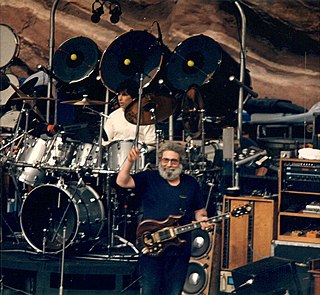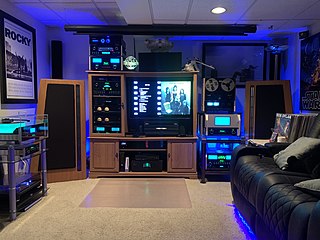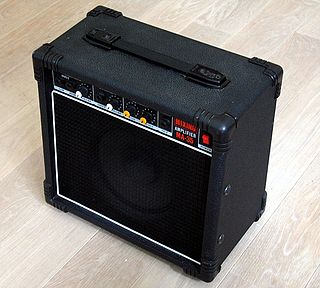
Jerome John Garcia was an American musician who was the principal songwriter, lead guitarist, and a vocalist with the rock band Grateful Dead, which he co-founded and which came to prominence during the counterculture of the 1960s. Although he disavowed the role, Garcia was viewed by many as the leader of the band. He was inducted into the Rock and Roll Hall of Fame in 1994 as a member of the Grateful Dead.

An audio power amplifier amplifies low-power electronic audio signals, such as the signal from a radio receiver or an electric guitar pickup, to a level that is high enough for driving loudspeakers or headphones. Audio power amplifiers are found in all manner of sound systems including sound reinforcement, public address, home audio systems and musical instrument amplifiers like guitar amplifiers. It is the final electronic stage in a typical audio playback chain before the signal is sent to the loudspeakers.

An instrument amplifier is an electronic amplifier that converts the often barely audible or purely electronic signal of a musical instrument into a larger electronic signal to feed to a loudspeaker. An instrument amplifier is used with musical instruments such as an electric guitar, an electric bass, electric organ, electric piano, synthesizers and drum machine to convert the signal from the pickup or other sound source into an electronic signal that has enough power, produced by a power amplifier, to drive one or more loudspeaker that can be heard by the performers and audience.

A guitar amplifier is an electronic device or system that strengthens the electrical signal from a pickup on an electric guitar, bass guitar, or acoustic guitar so that it can produce sound through one or more loudspeakers, which are typically housed in a wooden cabinet. A guitar amplifier may be a standalone wood or metal cabinet that contains only the power amplifier circuits, requiring the use of a separate speaker cabinet–or it may be a combo amplifier, which contains both the amplifier and one or more speakers in a wooden cabinet. There is a wide range of sizes and power ratings for guitar amplifiers, from small, lightweight practice amplifiers with a single 6-inch speaker and a 10-watt amp to heavy combo amps with four 10-inch or four 12-inch speakers and a 100-watt amplifier, which are loud enough to use in a nightclub or bar performance.

Sansui Electric Co., Ltd. was a Japanese manufacturer of audio and video equipment. Headquartered in Tokyo, Japan, it was part of the Bermuda conglomerate.

Scholz Research & Development, Inc. was the name of the company founded by musician and engineer Tom Scholz to design and manufacture music technology products.

McIntosh Laboratory is an American manufacturer of handcrafted high-end audio equipment headquartered in Binghamton, New York. It is a subsidiary of McIntosh Group, which is under the ownership umbrella of Highlander Partners, a Dallas-based private equity firm.

Alembic Inc. is an American manufacturer of high-end electric basses, guitars and preamps. Founded in 1969, the company began manufacturing pre-amps before building complete instruments.
Dynaco was an American hi-fi audio system manufacturer popular in the 1960s and 1970s for its wide range of affordable, yet high quality audio components. Founded by David Hafler and Ed Laurent in Philadelphia, Pennsylvania in 1955, it's best known product was the ST-70 tube stereo amplifier. They also manufactured other tube and solid state amplifiers, preamplifiers, radio tuners and bookshelf loudspeakers. Dynaco was liquidated in 1980, and the trademark is now owned by Radial Engineering Ltd.
The Summer Jam at Watkins Glen was a July 1973 rock festival outside Watkins Glen, New York, that featured the Allman Brothers Band, Grateful Dead and the Band. The July 28, 1973, event long held the Guinness Book of World Records entry for "largest audience at a pop festival," with an estimated 600,000 fans in attendance at the Watkins Glen Grand Prix Raceway. Approximately 150,000 tickets were purchased in advance, the rest being admitted in what became a "free concert".
Phase Linear was an audio equipment manufacturer founded by Bob Carver and Steve Johnston in 1970. While primarily known as a power amplifier company it also produced several innovative preamplifiers, tuners and the Andromeda loudspeaker.
A valve audio amplifier (UK) or vacuum tube audio amplifier (US) is a valve amplifier used for sound reinforcement, sound recording and reproduction.

A bass amplifier is a musical instrument electronic device that uses electrical power to make lower-pitched instruments such as the bass guitar or double bass loud enough to be heard by the performers and audience. Bass amps typically consist of a preamplifier, tone controls, a power amplifier and one or more loudspeakers ("drivers") in a cabinet.

The Wall of Sound was an enormous sound reinforcement system designed in 1973 specifically for the Grateful Dead's live performances. The largest concert sound system built at that time, the Wall of Sound fulfilled lead designer Owsley "Bear" Stanley's desire for a distortion-free sound system that could also serve as its own monitoring system. Due to its size, weight and resulting expense, the full WoS was only used from March to October of 1974.

Tiger is a custom-built guitar owned by Grateful Dead guitarist Jerry Garcia. Garcia commissioned luthier Doug Irwin to design and build the guitar in 1973 following delivery of Wolf, his first major Irwin-built guitar. Upon commissioning the instrument, Garcia asked Irwin to "make it the way he thought was best, and don't hold back." Tiger served as Garcia's main guitar from 1979 to 1989. It was the last guitar Garcia played publicly with the Grateful Dead at a Soldier Field performance on July 9, 1995.

Home audio refer to audio consumer electronics designed for home entertainment, such as integrated systems like shelf stereos, as well as individual components like loudspeakers and surround sound receivers.

Tube sound is the characteristic sound associated with a vacuum tube amplifier, a vacuum tube-based audio amplifier. At first, the concept of tube sound did not exist, because practically all electronic amplification of audio signals was done with vacuum tubes and other comparable methods were not known or used. After introduction of solid state amplifiers, tube sound appeared as the logical complement of transistor sound, which had some negative connotations due to crossover distortion in early transistor amplifiers. However, solid state amplifiers have been developed to be flawless and the sound is later regarded neutral compared to tube amplifiers. Thus the tube sound now means 'euphonic distortion.' The audible significance of tube amplification on audio signals is a subject of continuing debate among audio enthusiasts.

A keyboard amplifier is a powered electronic amplifier and loudspeaker in a speaker cabinet used for the amplification of electronic keyboard instruments. Keyboard amplifiers are distinct from other types of amplification systems such as guitar amplifiers due to the particular challenges associated with making keyboards sound louder on stage; namely, to provide solid low-frequency sound reproduction for the deep basslines that keyboards can play and crisp high-frequency sound for the high-register notes. Another difference between keyboard amplifiers and guitar/bass amplifiers is that keyboard amps are usually designed with a relatively flat frequency response and low distortion. In contrast, many guitar and bass amp designers purposely make their amplifiers modify the frequency response, typically to "roll-off" very high frequencies, and most rock and blues guitar amps, and since the 1980s and 1990s, even many bass amps are designed to add distortion or overdrive to the instrument tone.

The NAD 3020 is a stereo integrated amplifier by NAD Electronics, considered to be one of the most important components in the history of high fidelity audio. Launched in 1978, this highly affordable product delivered a good quality sound, which acquired a reputation as an audiophile amplifier of exceptional value. By 1998, the NAD 3020 had become the most well known and best-selling audio amplifier in history.


















